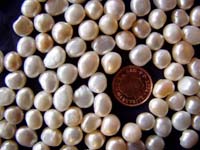This website uses cookies so that we can provide you with the best user experience possible. Cookie information is stored in your browser and performs functions such as recognising you when you return to our website and helping our team to understand which sections of the website you find most interesting and useful.
Scottish River Pearls: What you must know
In her lyrical novel Dear, Thief (Jonathan Cape, 2014), Samantha Harvey sends her characters to Scotland hunting for pearls. Her description is vivid: “To fish for river pearls you need shallow, fast-flowing water. You lower a glass-bottomed bucket into the river and scan the gravel bed, and if you find a mussel you use your hands or a cleft stick to pick it out, and you break it open. There will almost never be a pearl inside.”
It’s not long before her characters discover what we knew all along: fishing for Scottish river pearls is illegal! It is prohibited to disturb, injure, take or kill a freshwater pearl mussel.
Lest there be any doubt about what this means, here is the information from www.gov.scot:
“It is an offence to intentionally or recklessly kill, injure, take or disturb freshwater pearl mussels or to damage their habitat.
It is also illegal to possess mussels or pearls collected since 1998 (when the law was changed to give them further protection)
It is illegal to sell, or advertise for sale, freshwater pearl mussels or their pearls unless done under licence from the Scottish Government.”
What are freshwater pearl mussels? The Scottish National Heritage website explains: “[They] are similar in shape to common marine mussels but grow much larger and live far longer than their marine relatives. Incredibly, they can live for more than 100 years, making them one of the longest-lived invertebrates. They can grow to as large as your hand and are dark brown to black in colour. They live at the bottom of clean, fast-flowing rivers, where they can be completely or partly buried in coarse sand or fine gravel. They feed by drawing in river water and filtering out fine particles. Each day an adult is able to filter more water than we use in an average shower. They have a complex lifecycle and, in their first year, they harmlessly live on the gills of young salmon or trout.”
The mussels — along with the fish population — are in danger from over-farming, climate change and poaching. (For more information about this threat and what you can do to help, visit: http://www.gov.scot/Topics/Environment/Wildlife-Habitats/paw-scotland/Resources/Newsletters/Issue2/Seasonal/SeasonalcrimeFWPM.)
Years ago we sold a big Tay River pearl — it was a fantastic thing. Today that would be impossible. The law requires anyone trading to have a special license for these pearls, and that license is granted on an item-per-item basis. Additionally, only known items may be traded, since this implies that they were harvested prior to 1998. In practise, this means that if a member of the public has a string of Scottish river pearls, even if they’ve been in the family for years, they need to obtain a special license to sell them to us — or anyone else. In order to sell the necklace on, the law requires us to obtain a new license specifically for that piece.











